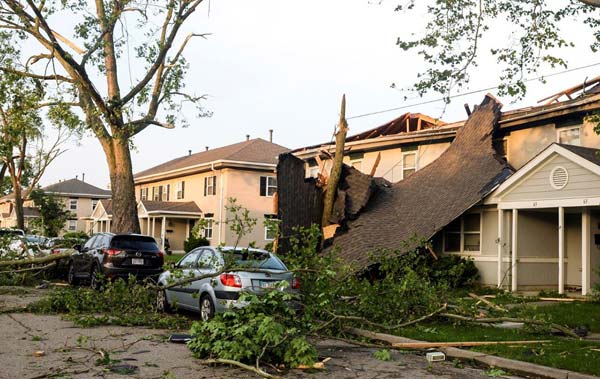When a severe storm hits your town, it can cause a lot of anxiety, concerns, and stress. If your lucky, your house might make it through the storm unscathed. However, at other times the damage to your home can be severe. What should you do?

If your home is damaged in a storm, you might be feeling overwhelmed. Where do you start? A storm can cause so much damage, such as knocking down power lines or fallen trees landing on your fence, roof or car. After the wind has gone, you need to walk the exterior of your home to get an idea of the damage done and to make sure your home is still safe to live in.
Below are some tips to help you after a storm has damaged your home:
- Do not go outside until it has been declared safe
- Listen to advisories and other instructions
- Don’t go near downed power lines, and avoid any standing water or metal objects that are near any downed wires
- Leave and do not enter any buildings that have structural damage
- Do not go near damaged trees or any dangling or broken limbs
- If you need to drive, watch for undermined roads, and avoid driving through any flooded streets or bridges
- Make sure your sewer system is working
- Keep your pets indoors and leash them if they have to go outside
- If you smell gas, turn the gas off at the meter
In the aftermath of your home being damaged by a storm follow these steps below:
1. Safety First
Storms can cause a variety of problems, and some of them can be dangerous. So it is crucial to be aware of any possible harmful situations that you can happen upon, including downed power lines, broken windows, flooding, or severed gas lines.
These situations are hazardous and need to be approached carefully. If you smell gas, do not re-enter your home.
2. Inspect the Damage that You are Dealing With
When you feel confident that there is no storm danger inside the home, thoroughly inspect the outside of your home. During your inspection, check each room in your home and around your yard. As you are examining the damage, take notes of big and small issues.
3. Document Storm Damage
You will need to document any storm damage to both the interior and exterior of your home. Write things down and take photos to provide evidence when it is time to make an insurance claim. The photos will help show the before and after so the insurance company cannot deny that the storm does the damage.
4. Contact Your Insurance Company
After documenting your damage, you will have to contact your insurance company, which will send an adjuster to evaluate any damage on your property. Then the adjuster will let you know how much they will cover once you pay the deductible. Keep in mind, much of the storm damage will be covered but certain things may not.
5. Choose a Reliable Contractor for Repairs
When you know the amount that the insurance company will cover, you can start researching reliable contractors to do the repairs. When you are searching for someone to complete the repair or rebuild jobs don’t be afraid to ask lots of questions. You have been through a lot of stress already by living through the storm and seeing your home damaged, and you want to make sure you are selecting a contractor that is going to do the job correctly.
The Takeaway
If a storm has hit your house, you need to remember safety first. When it is deemed safe, it is time to assess the damage done to the interior and exterior of your home, such as tree limbs causing holes in the roof or shingles that have blown off.
Windows and doors can be vulnerable to wind damage. Inspect for any cracks or holes in the glass. Do a detailed examination of your home and document the damage as you go along. When you’ve documented the damage, it is time to report the damage to your insurance company.
When your claim has been approved, search for a reliable contractor to hire. Since the insurance company is covering the cost of hiring a contractor, at least this part of the process is far less painful.



